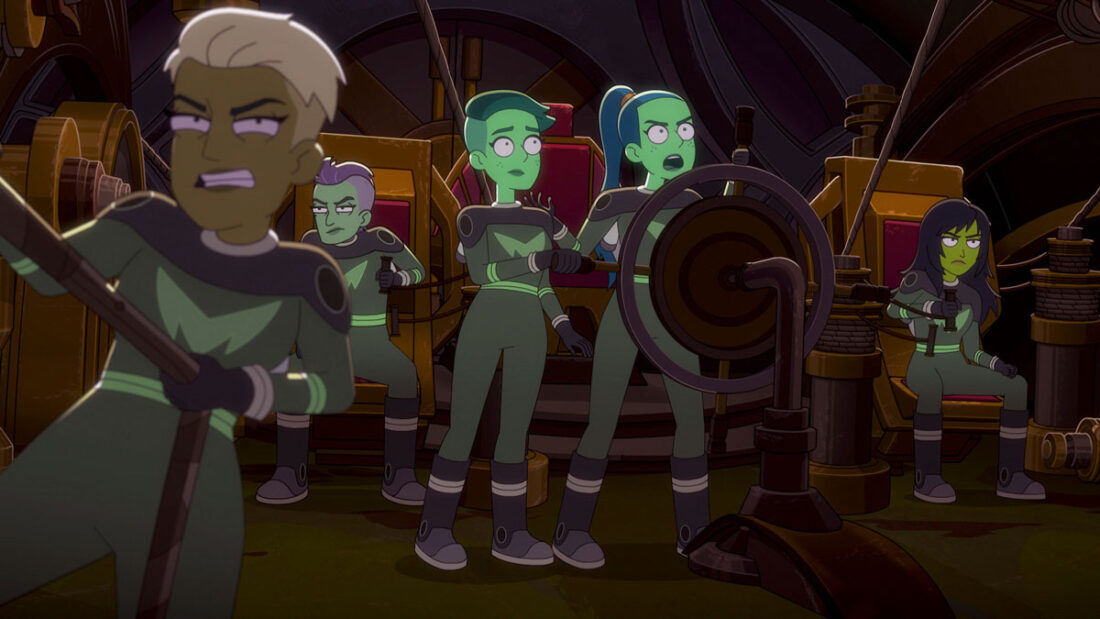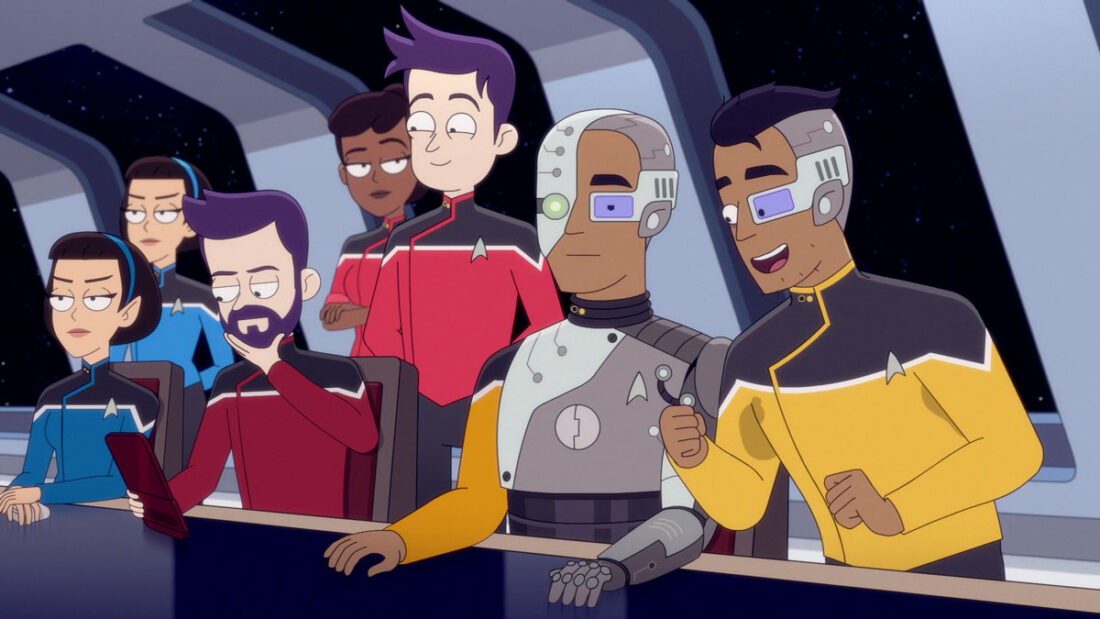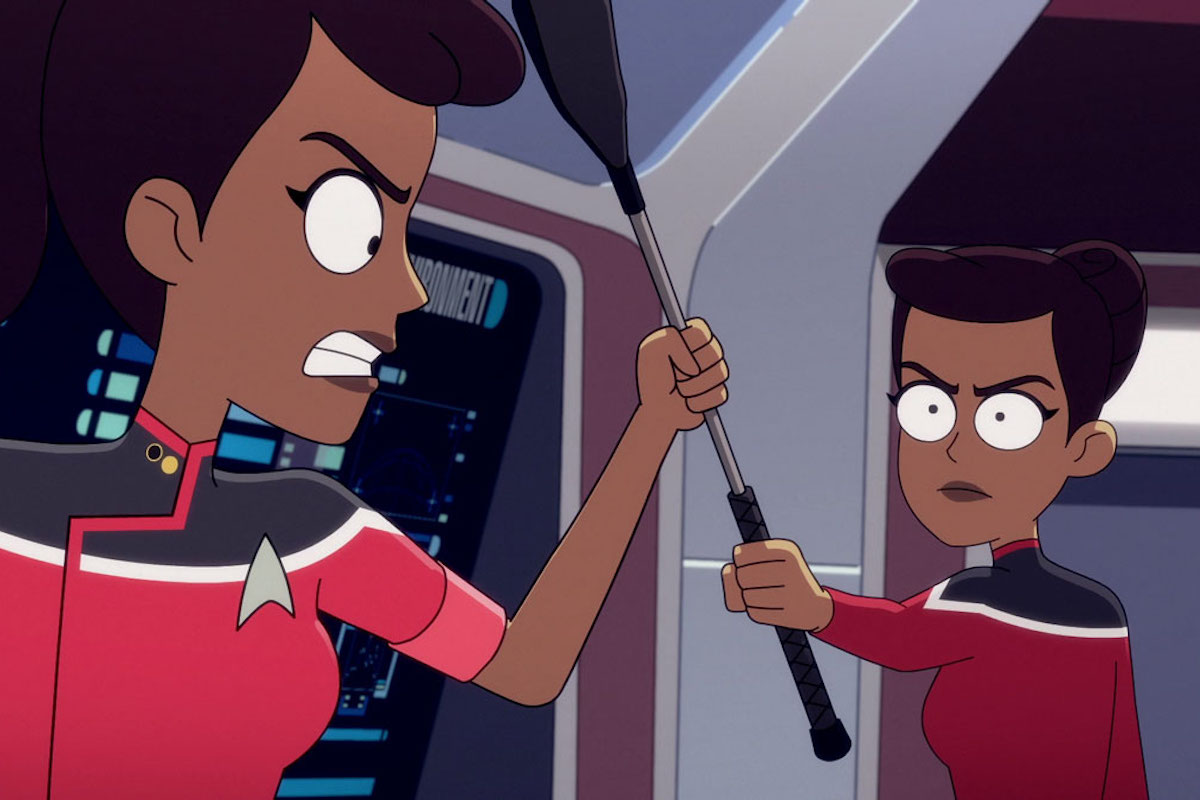One of the common tropes of a long-running serial narrative like Star Trek is that you can do retcons. Short for retroactive continuity, a retcon puts a new spin on an existing bit of lore. Sometimes it’s to reconcile an inconsistency, sometimes it’s to put a new spin on an old story, and sometimes it’s to fix a mistake. (As an example, Strange New Worlds has done a lovely job of retconning the Spock-Chapel relationship in the original series by establishing that they dated in the past.)
Lower Decks has already done a certain amount of retconning of the Orion people. Indeed, they’ve given us a retcon of a retcon. When they were introduced way back in “The Cage” in 1964, they were described by Dr. Boyce as “green animal women,” who were there for sex appeal, and who were traded as slaves. Enterprise then retconned Orion women in 2005’s “Bound” as being the real brains of the Orion people, using pheromones to make men stupid in their presence. LD, thankfully, fixed that, making it a bit more nuanced.
But there was one appearance of the Orions that had not been taken into account one way or the other: the species’ appearance in the animated episode “The Pirates of Orion.” That animated episode was mostly ignored up until this new fifth season of LD, but this show is never happier than when it’s embracing the entirety of the Trek universe—even the goofy parts.
Especially the goofy parts.
The animated series was produced by Hal Sutherland, who had issues with colors, which resulted in some entertaining palate choices on the show (e.g., pink tribbles). So the Orions, established in “The Cage” as well as “Whom Gods Destroy” as having green skin, instead had blue skin. In addition, the uniforms they wore were, to say the least, goofy, and also every voice actor was given bad information as to the pronunciation of “Orion.” (Everyone in the episode pronounced it “ORE-ee-un,” rather than “oh-RYE-un.”)
The two-episode debut of LD’s fifth and, sadly, final season makes this seeming discontinuity into a plot point. The blue-skinned Orions are one of the many races among the Orion people—which only makes sense, given the variations in pigments among other humanoid species on Trek. They all pronounce their species name “ORE-ee-un,” and they’re proud of their silly outfits.

The B-plots of each of the two new episodes focus on Tendi, last seen taking a leave of absence from Starfleet in order to fulfill her duties as the Mistress of the Winter Constellations, pirating for her sister D’Erika. And because Tendi is still Starfleet through and through, she tries very hard to be a kinder pirate. In particular, she doesn’t want to kill anyone while plundering.
Unfortunately, this gets her in trouble. First the blue Orions are pissed that she’s not following the spirit of pirating in “Dos Cerritos.” That leads to a war between the blue Orions and House Tendi. This pisses off the Orion queen in “Shades of Green,” who says this war is taking time away from proper plundering. So they must do a solar-sail race through a nebula and retrieve a treasure. The winner gets all the loser’s wealth.
Tendi once again acts more like a Starfleet officer than a pirate in two critical ways during the race. One is that she accidentally discovers that D’Erika is pregnant. This results in tiresome sitcom nonsense where Tendi tries to keep her sister from doing anything strenuous. The other is more useful: when the Tendi solar ship crashes (because the blue Orions fired on them with rifles), Tendi is able to technobabble a solution.
But once again her attempt at compassion—to wit, having both ships come in together in a tie—fails, as the Orion queen doesn’t let them all keep their wealth. Instead, the queen claims both sides’ wealth, leaving them both destitute.
Luckily, there’s an out that Tendi is able to provide once she reports back to the Cerritos, D’Erika having decided that she’s paid off her debt. The ship has been assigned to Targalus, which has just joined the Federation and is having a currency-destroying party now that they are enjoying the fruits of the post-scarcity replicator-based economy of the Federation.

Once again, we get LD looking at the loopier side of Trek, taking things to their absurdist extreme. If a planet is moving to the moneyless economy of the Federation, of course they would celebrate by getting rid of all their money. We see paper money being burned and jewels and such being abandoned.
Since the Cerritos was just going to recycle all the jewels and gold anyhow, instead, at Tendi’s suggestion, Freeman donates it to D’Erika, who then can restock House Tendi’s wealth and make them an important family again. Plus it improves relations between the Federation and the Orions…
The premiere episode gives us an old Trek standby: the alternate universe story. An attempt to close a quantum fissure leads the Cerritos into a parallel timeline which is just different enough to be weird. Shaxs has long hair, Billups embraces his status as a member of the Hysperian royal family (he wears a coronet and cape over his uniform), Ransom has a mullet, Boimler is bearded and confident, and T’Lyn says “Remarkable” rather than “Fascinating” (which, of course, is literally the only difference between the two). The biggest changes, though, are to Mariner, Rutherford, and Freeman. Mariner has gone back to using her family name of Freeman, and is now the commanding officer, Captain Becky Freeman. As for her mother, she’s apparently been assigned to Starbase 80 (a fate worse than death, as established back in “Terminal Provocations” and seen in “Trusted Sources”).
And then there’s poor Rutherford. The mainline version has been neglecting things like personal hygiene and friends, instead throwing himself completely into his work to distract himself from the fact that his best friend is gone. But “Otherford,” as Rutherford calls him, has taken that to an extreme: he’s more cyb than org, as it were, and has shut off all his emotions and erased his memories of Tendi. This proves to be a watershed moment for Rutherford, who doesn’t want to become all Borg…
As for Mariner’s counterpart, she proves to be a bigger hardass than her mother ever was, going so far as to whack subordinates with a riding crop if they get out of line. But then we find out that she hates being captain, and pulls a Lore-in-“Datalore” and swaps places with Mariner, hoping to be the carefree junior officer who does what she wants once again.
Boimler is particularly taken with his counterpart, and in “Shades of Green,” we see him working on facial hair and doing things he’s found in his counterpart’s service record, pulled from a padd he liberated from the alternate timeline. One of those is “Bointers,” different pointers on how to behave. At first it seems like the ensigns he’s bossing around are not thrilled with this, but they actually are able to use a “Bointer” to save their lives when they’re kidnapped by formerly rich Targalans who don’t want to give up being wealthy and powerful.

I have to admit to some minor disappointments with “Dos Cerritos.” Usually the fun of these things is to watch the actors play different versions of themselves, but they’re not quite different enough—especially not vocally—for it to matter that much. The exceptions are Gabrielle Ruiz’s T’Lyn, as the fact that she sounds exactly the same is part of the joke, and Tawny Newsome’s Mariner/Freeman, as she’s the most different. Seeing the alternate Cerritos crew flinch around their captain is heartbreaking, and we learn that Mariner is the worst in any timeline, as she goes from being a horrible junior officer to being an incredibly horrible captain. I hope that this results in some changes to Mariner, but her changes to date have been incremental to nonexistent, so I’m not holding my breath.
Boimler, on the other hand, has been genuinely developing, his natural talent swimming upstream against his insecurities. It’s especially frustrating to see him go all-in on doing what his counterpart does when it isn’t necessary—but it’s also completely in character. In addition, the banter between Boimler and Mariner has gotten much more fun since Boimler got more confident. It feels more like best-friend banter than the more abusive relationship they had in the first season, and Newsome and Jack Quaid have superlative friendly chemistry. (“Let’s do this!” “Yes, totally—but you are sitting on it backwards.” “Dammit!”)
I adored the subplot in “Shades of Green” involving T’Lyn and Rutherford. For one thing, Rutherford is the only one of the “big four” who hadn’t had significant one-on-one scenes with T’Lyn up until now. And it’s heartening to see T’Lyn trying to help Rutherford through his post-Tendi funk, first by encouraging him to work on the shuttlecraft that he and Tendi had been repairing. Once she discovers that he’d been avoiding working on it because it was his and Tendi’s project, T’Lyn proceeds to completely demolish the shuttlecraft so the pair of them can continue to work on it. It’s incredibly adorable.
After a really rocky first season, LD has settled into an absolute delight of a Trek show, mostly because it’s embraced its most successful version of itself: a Star Trek comedy, rather than a twenty-first-century office comedy with Trek bits. It’s still very much a Trek show in all the most important ways: the themes of both these episodes are to not be mean to other people and to be the best version of yourself.
I’m gonna be sorry to see it go, and Paramount+ should be ashamed of themselves for cancelling it.
Random thoughts
- I was really worried about “Shades of Green” from the title, which feels like a riff on “Shades of Grey,” the nadir of The Next Generation as a TV show. Luckily, this wasn’t a clip show like that 1989 TNG disaster, but rather a descriptive title, since so much of the episode is about the green-skinned Orions versus the blue-skinned ones.
- “Dos Cerritos” opens with a delightful heist sequence, as Tendi goes undercover on a ship run by someone of the same species as Palor Toff, the character played by Nehemiah Persoff in TNG’s “The Most Toys.” At one point, one of the Orions wants to tear out the twisty metal band that runs from ear to nose, with the poor alien crying in protest that “it’s prescription!” which is hilarious.
- The quantum fissure seen in “Dos Cerritos” is very much like the one that started the plot going in TNG’s “Parallels,” one of Trek’s better alternate-timeline episodes.
- Other examples of alternate-timeline versions of familiar characters include the original series’ “Mirror, Mirror,” TNG’s “Yesterday’s Enterprise,” DS9’s “Crossover,” “Through the Looking Glass,” “Shattered Mirror,” “Resurrection,” and “The Emperor’s New Cloak,” Voyager’s “Living Witness” (sort of), Enterprise’s “In a Mirror, Darkly” two-parter, Discovery’s “Into the Forest I Go,” “Despite Yourself,” “The Wolf Inside,” “Vaulting Ambition,” “What’s Past is Prologue,” and the “Terra Firma” two parter, Picard’s “Penance,” and Prodigy’s “Cracked Mirror.”
- For those who might think it silly that some Orions pronounce it “ORE-ee-un” rather than “oh-RYE-un,” I present as evidence my mother’s side of the family. The branch of the Andreassi family that is in the New York Metropolitan Area pronounce it “an-dree-AH-see,” while the branch of the same family that is in western Pennsylvania pronounce it “an-DRESS-ee.” Mind you, this drove my paternal grandfather crazy whenever he visited family in Pennsylvania, though it was on one of those trips that he met my grandmother, so he probably got over it…

